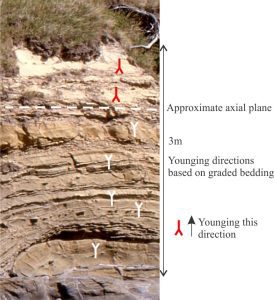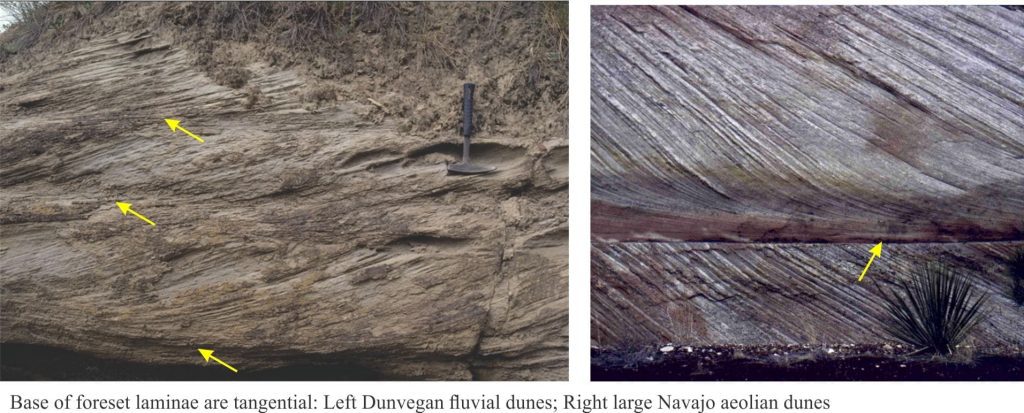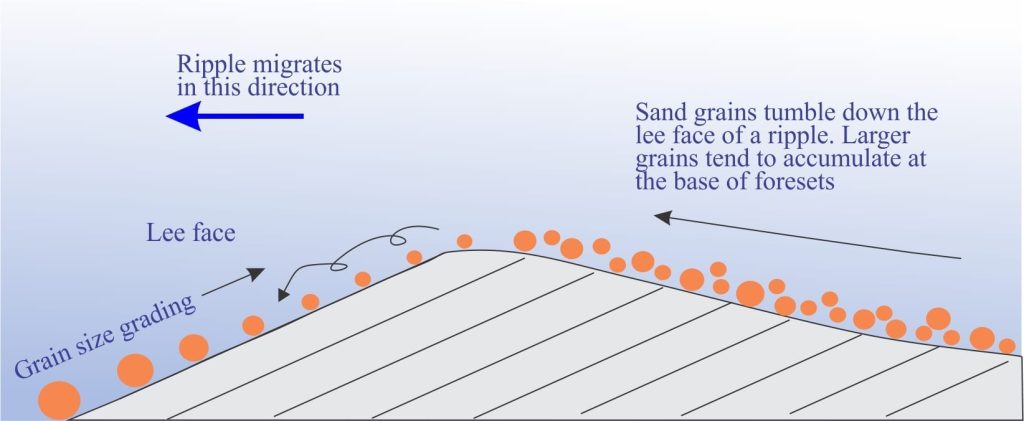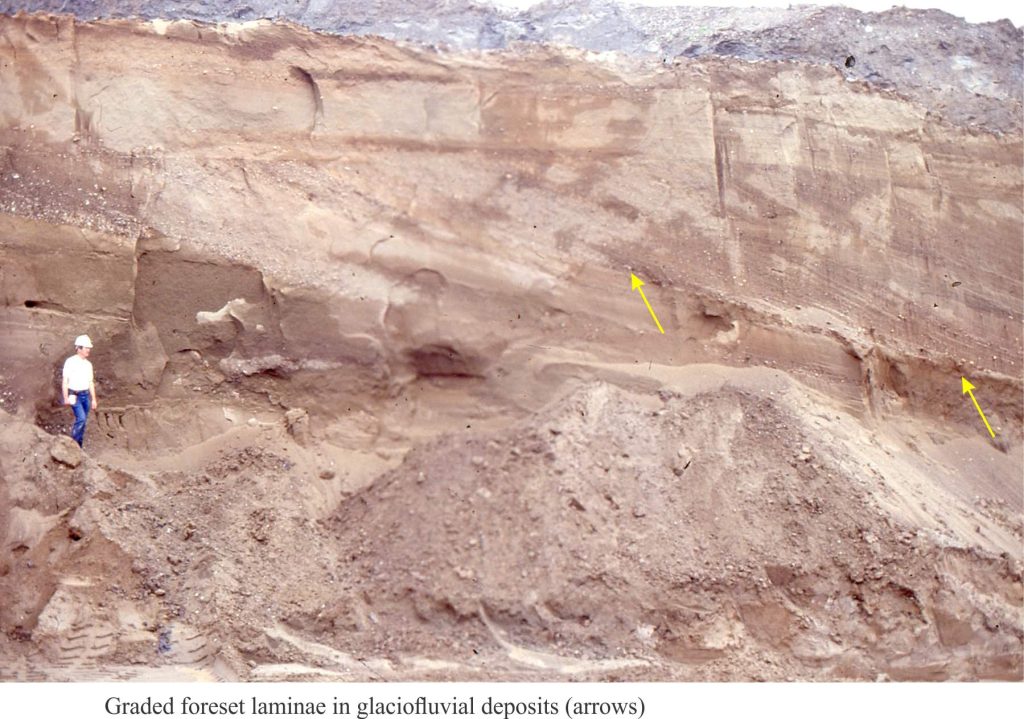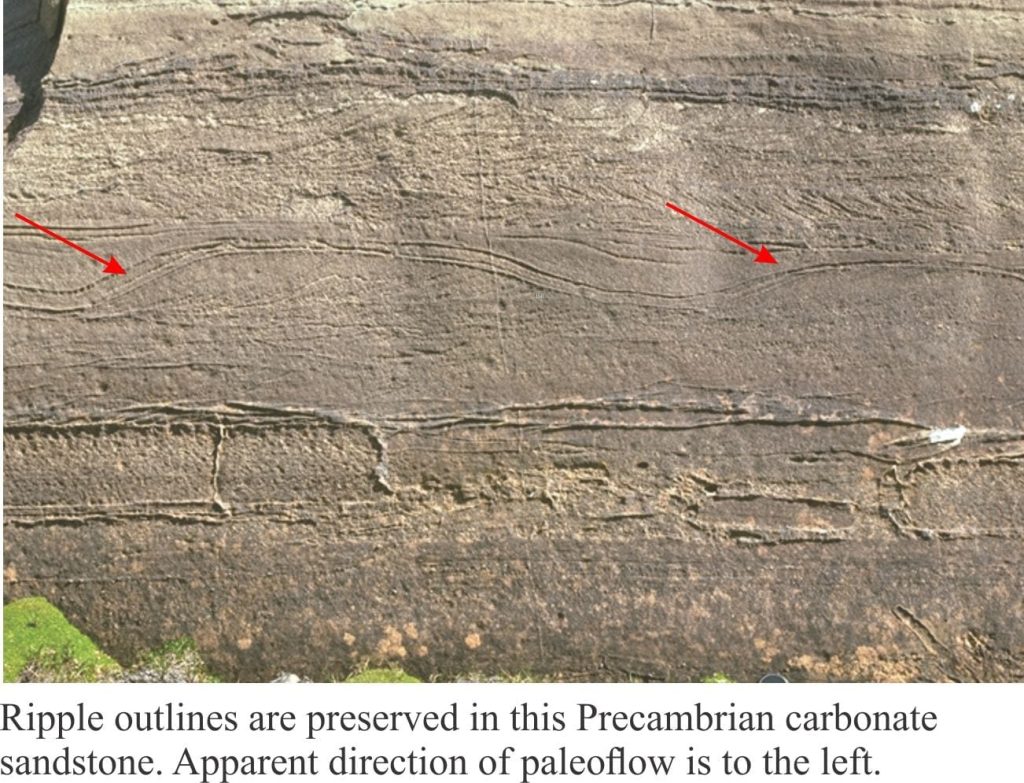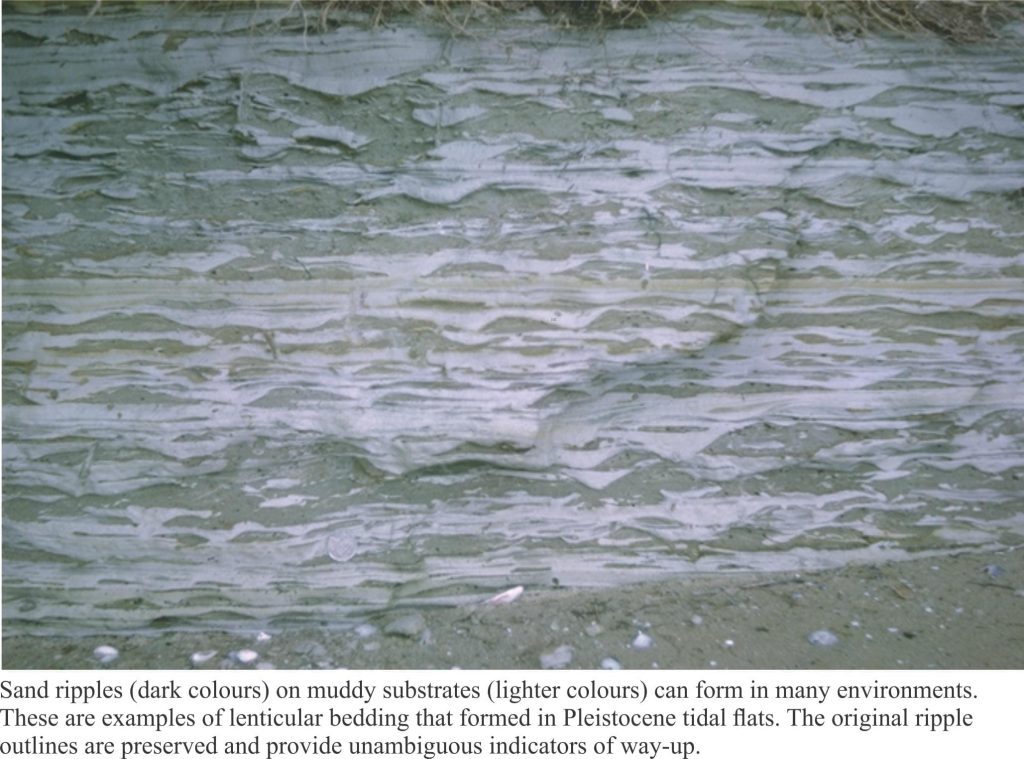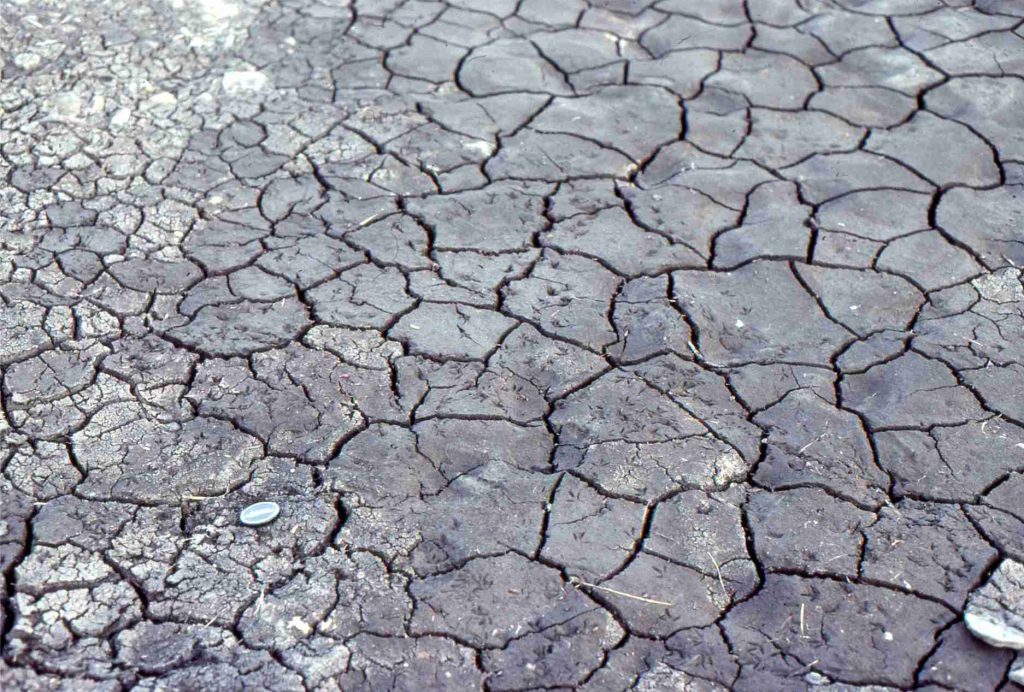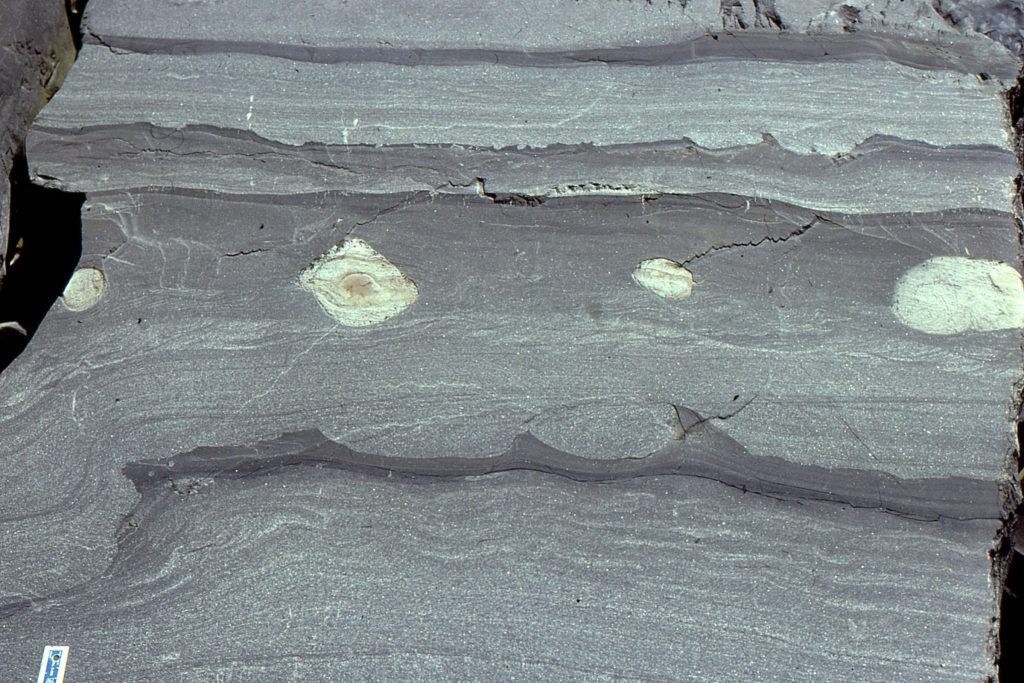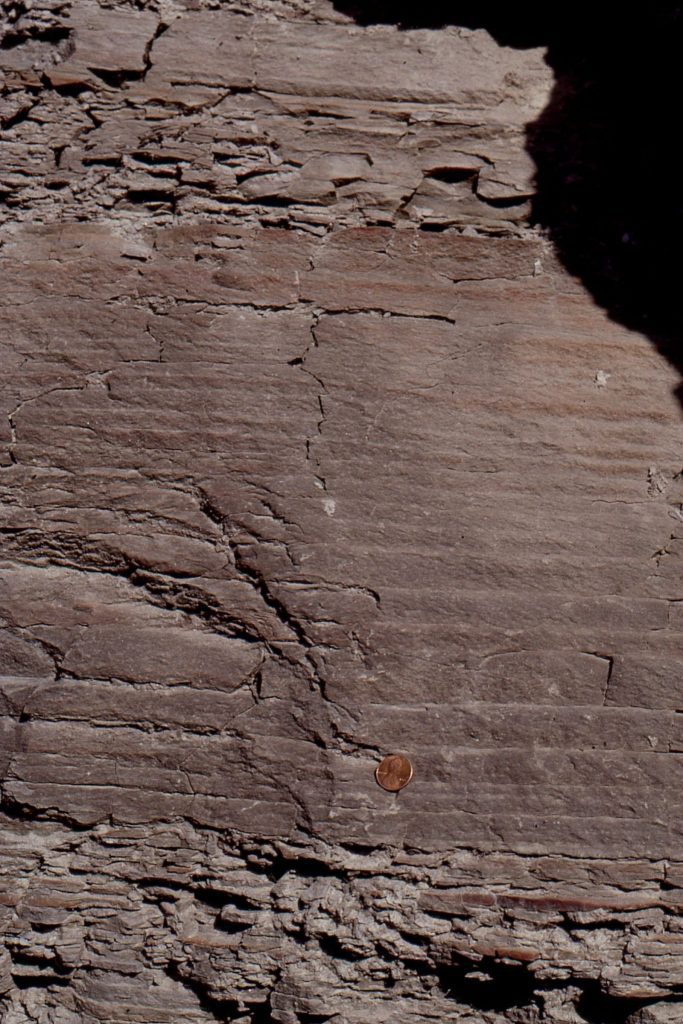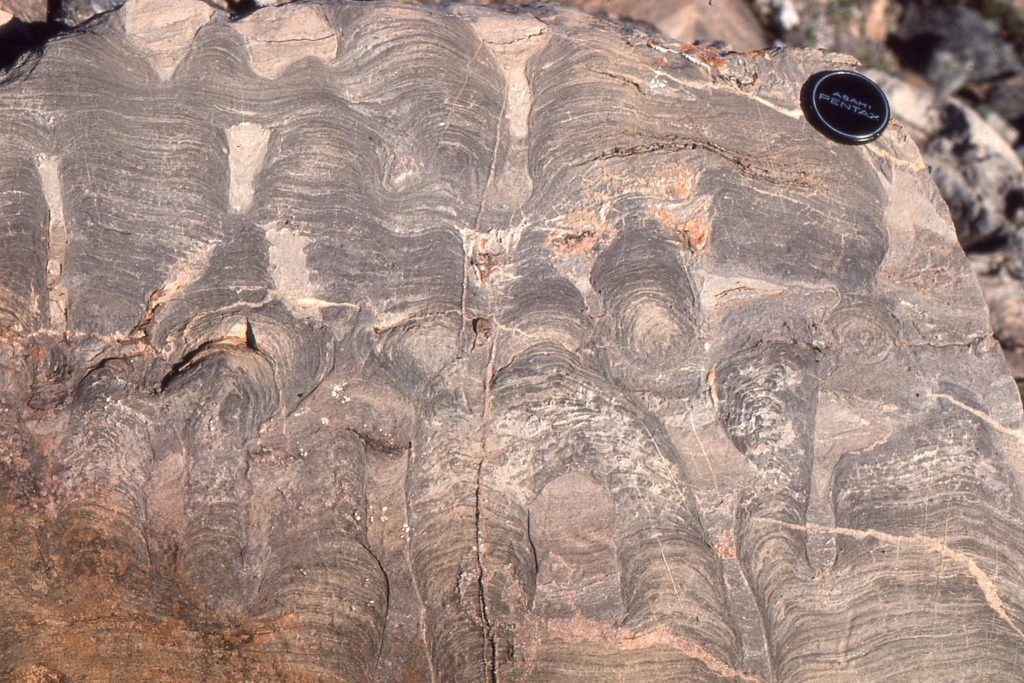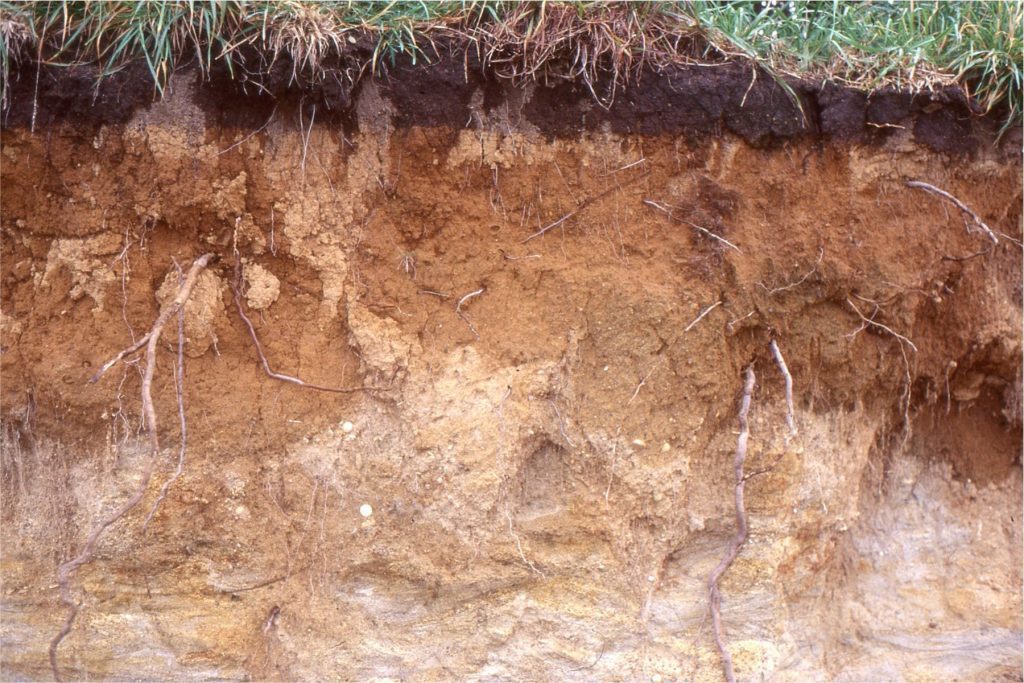a.k.a. Stratigraphic way up, or younging direction
This post is part of the How To… series
Stratigraphy is all about succession in the rock record – which events preceded other events; which is older, which younger. Nicolas Steno (1638-1686) surmised, and four centuries of geologists since have confirmed that in an uninterrupted succession of strata, the youngest layer is at the top. However, tectonic hiccups and upheavals have frequently turned successions of strata sideways or on their head. In this case, knowing which way is ‘up’ will confirm which strata were overturned.
This important condition is illustrated in the image below where the package of sedimentary beds appears continuous. On closer inspection it is discovered that beds in the lower part of the package are upside down, whereas those above are the right way up. This tells us that we are probably looking at a recumbent fold. If we had only given this outcrop a casual glance we might miss the structural complication – our measured stratigraphic thickness would be twice its correct value, and we would have missed a vital part of the geological story.
Evaluating stratigraphic succession is commonly done using fossils and radiometric dating. However, these two methods don’t apply easily to the kind of outcrop-scale problem shown above. Instead we use structures observed in single beds or groups of beds to decipher way up, or younging direction.
Below are some common sedimentary and bio-sedimentary structures that are useful for this purpose. Be aware that there is a degree of ambiguity for most of these structures; it is best to use as many different criteria as possible to be certain of your decision. This problem can be acute in very fine-grained, laminated or thin-bedded rocks containing lots of mud (clay plus silt), for example in many turbidite, prodelta, slope and lacustrine mudrocks.
Crossbedding: There are many different kinds of crossbeds that form in a range of depositional settings and hydraulic conditions. Some of the more useful attributes are shown here.
Crossbed laminae commonly terminate abruptly at the top of foresets and are tangential with the sediment bed at their base. This is one of the more useful attributes of crossbeds for determining younging direction.
In larger crossbed sets where there is a range of clast sizes, it is common to see larger grains at the base of foreset laminae; i.e. individual foreset laminae may be graded along the plane of the lamination – coarse at the base, finer at the top.
Bedforms preserved intact and visible in cross-section or on bedding provide reasonably unambiguous evidence for way-up. Good examples are starved sand ripples that migrated across a muddy substrate, for example across tidal flats, or larger dunes in sandstone.
Mudcracks form in muddy sediment exposed to prolonged periods of drying. The cracks are usually V-shaped, tapering downwards. Desiccated layers may curl upwards. The example of modern mudcracks (below left) shows a surface expression of polygons. The cross-section (right) shows desiccated mudstone curled at the edges (lower half of image); this example is from the 2 billion year old Belcher Group of Hudson Bay.
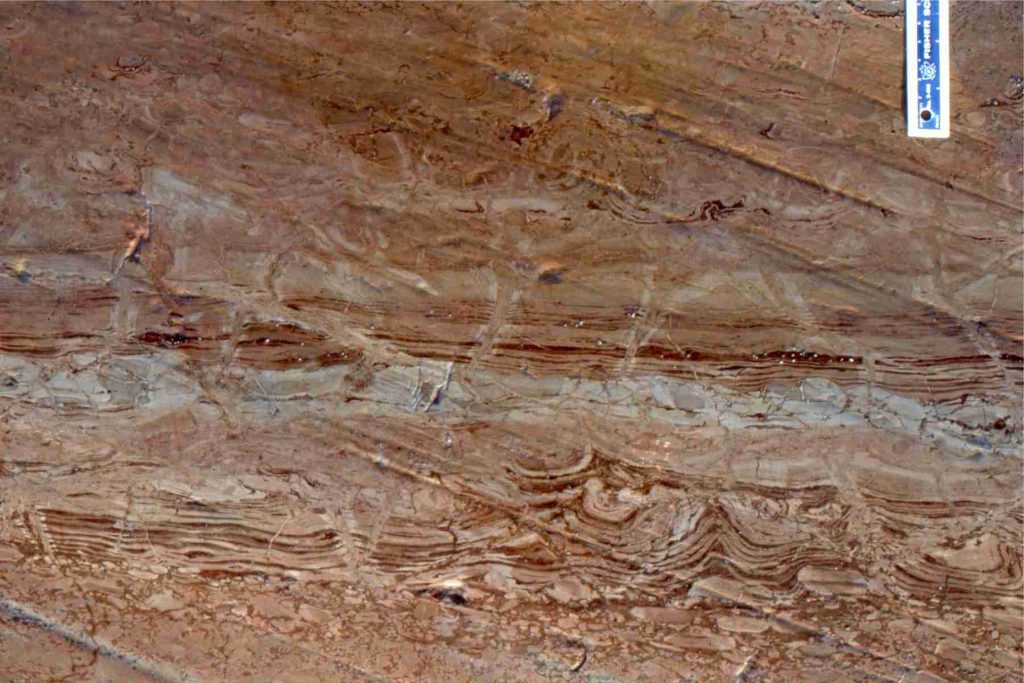

Ancient mudcracks exposed in cross-section, showing typical up-turned edges. The more pebbly unit at the bottom is a storm deposit where desiccated mud was ripped up and redeposited
Graded bedding in a single depositional unit typically exhibits coarsest grains at the base, becoming finer grained towards the top. Graded bedding is a defining characteristic of turbidites, but is also common in mud-dominated prodelta and slope settings. Keep in mind that reverse grading is possible under certain hydraulic conditions (e.g. some debris flows). Ideally, grading should be noted in as many beds as possible to avoid ambiguity.
Above image: Five turbidites with graded bedding (Precambrian of Belcher Islands). Note the flame structures at the base of two beds (see comments farther down this page)


Thin bedded, graded, fine-grained sandstone-mudstone slope deposits (Jurassic, Bowser Basin, B.C. Canada).
Sole structures are erosional or impact structures that form at the top of a bed, but are commonly observed as casts on the base or sole of the overlying bed – hence the name. Frequently encountered examples are flute and groove casts. The large flute casts below indicate stratigraphic top above the hammer.
Load casts are common in interbedded sandstone-mudstone successions (such as turbidites). They form soon after deposition during early stages of compaction and sediment dewatering, at the contact between sandy and muddy layers. Load casts generally extend into the underlying mud. Flame structures form between closely spaced load casts, their wispy, pointy tips squeezed upward into the sandy bed (see turbidite image above for examples).
Erosional bed contacts – erosion across a sediment surface commonly produces scours of difference shapes and sizes. Where there is a range of grain sizes, coarser sediment may fill the entire scour, or occur as a veneer or lag on the erosion surface. They are common in channels but can potentially form over any depositional surface.


Erosional scour and fill from Blacks Beach California shows Eocene submarine canyon scours filled with sand and pebbles.
Trace fossils are probably the most ambiguous of all sedimentary structures for determining way-up. Trace morphology tends to reflect an animal’s behaviour; thus the same animal can produce more than one kind of burrow, and different animals can produce the same kind of burrow or trace.
However, there are a few basic forms that will indicate stratigraphic top, for example U-shaped burrows like Diplocraterion and Rhizocorallium, and the cork screw-like Zoophycus shown below (top towards the viewer).
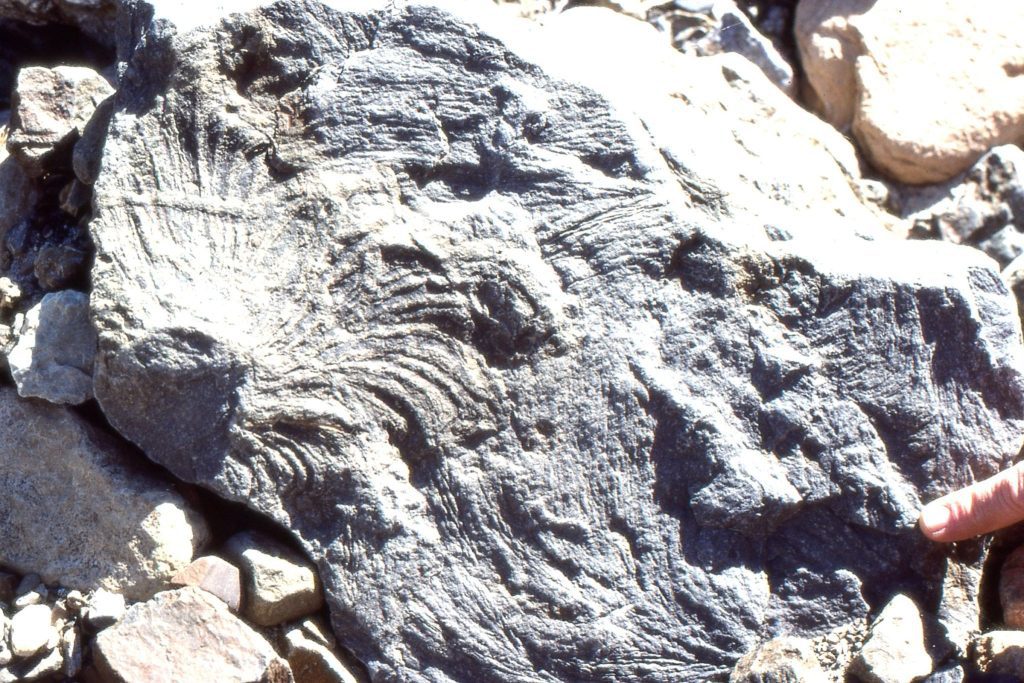

A Permian Zoophycus trace fossil, viewed looking down on bedding. The typical corkscrew pattern usually trends downward into the sediment. Ellesmere Island.
Cryptalgal laminae in digitate and domal stromatolites most commonly are flat to convex upward. These are particularly useful in Precambrian rocks. The example below is about 2 billion years old, from the Belcher Islands.
Paleosols Soil – paleosol profiles usually present an abrupt top and a more gradational transition to the underlying bedrock or sediment. In the case of organic paleosols, a carbon-rich layer would grade downward into partially or non-weathered bedrock. Root structures that branch downward are useful in this regard.
Prolonged exposure to surface weathering can also produce carbonate (caliche) and silica (silcrete) rich crusts where the degree of cementation of sediment or rock decreases downward to relatively unaltered parent material.


A Precambrian caliche (carbonate crust – below the scale) containing spheroidal, interlocking pisoliths. The ancient cementation front merges downward into the underlying carbonate mudstone.
Volcanic lava flows and pillowed flows. Lava flowing across a surface will tend to incinerate vegetation and bake the underlying sediment. Common indicators are charred wood and brown to rust-red baked substrate, or porcellanite at the base of a flow, but not at the top. These indicators also serve to distinguish lava flows from igneous sills. Superheated steam (from plants and soil moisture) may rise through the flow base forming narrow pipes, or spiracles that during burial will fill with mineral precipitates like calcite or zeolite (see image below). However, the flow-base spiracles may be ambiguous because they can also form on both upper and lower boundaries of igneous sills.


Gas-vapour bubbles have formed pipes, or worm-like vesicles where lava has flowed over a wet substrate.
Bulbous to lozenge-shaped lava pillows tend to be stacked in piles across the sea or lake floor. In most cases the pillows themselves are not indicative of stratigraphic tops. However, sediment (particularly fragmental debris) will gradually accumulate in the voids between stacked pillows. Any part of the voids not filled by sediment will eventually be cemented by minerals like calcite. Partly filled voids are good indicators of stratigraphic way up. Structures like these, referred to as geopetal indicators, also form in sedimentary rocks containing fossils like brachiopods and gastropods that have chambers open to sediment or cement fill, and in porous carbonates where voids may fill with a variety of cements.
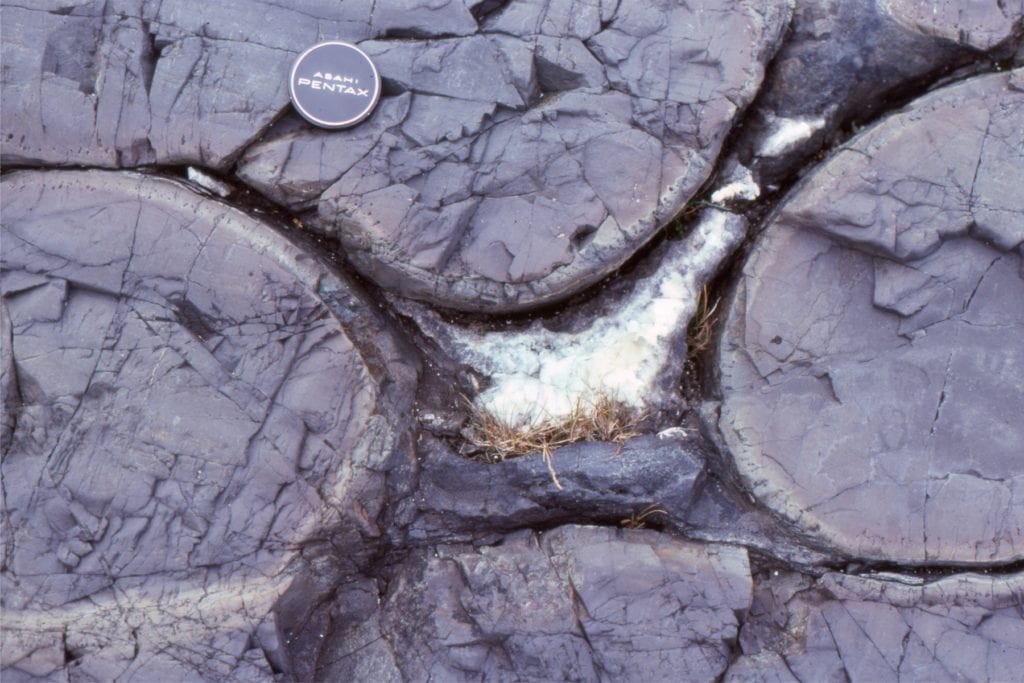

An example of geopetal structure as a void between four pillows, where the bottom layer of fragmental debris is overlain by coarse calcite and prehnite cements. Stratigraphic top here is definitive. Belcher Islands.
Some more useful posts in this series:
Determining stratigraphic tops
Measuring a stratigraphic section
Identifying paleocurrent indicators
Crossbedding – some common terminology

